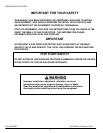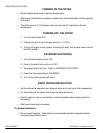
GRM SERIES GAS FRYERS
VULCAN-HART F-31233 Rev. K (February 2011)
-7-
ASSEMBLY
The fryer must be restrained to prevent tipping and the splashing of hot liquid. The means
of restraint may be the manner of installation, such as connection to a battery of
appliances, installing the fryer in an alcove, or by separate means such as adequate ties.
FLUE CONNECTION
Make the flue connection as follows:
Comply with Vapor Removal from Cooking Equipment, ANSI-NFPA Standard #96
(latest edition), available from the National Fire Protection Association,
Batterymarch Park, Quincy, MA 02269.
Locate the fryer under a hood with adequate connection to an exhaustduct. The
hood must extend 6” (15 cm) beyond fryer on both sides.
Clearance above the fryer should be adequate for combustion byproducts to be
removed efficiently.
An 18” (46 cm) minimum clearance should be maintained between the flue vent
and the filters of the hood venting system.
Never make flue connections directly to the fryer.
Do not obstruct the flow of the gases from the appliance. Proper air balance should
be maintained in the room.
Ensure that your ventilation system does not cause a down draft at the fryer’s flue
opening. Down draft will not allow the fryer to exhaust properly and will cause
overheating which may cause permanent damage. Damage caused by down draft
will not be covered under equipment warranty. Never allow anything to obstruct the
flue or ventilation exiting from the fryer flue. Do not put anything on top of flue area.
GAS CONNECTION
All gas supply connections and any pipe joint compound must be
resistant to the action of propane gases.
The gas inlet is located on the lower rear of the fryer. Codes require that a gas shutoff
valve be installed in the gas line ahead of the fryer.
The gas supply line must be at least the equivalent of ½” (12.7 mm) iron pipe for single
units and 1-1/4” (31.75 mm) for batteries. If using the optional quick-disconnect flex hose,
¾” (19 mm) iron pipe for single units and 1-1/4” (31.75 cm) iron pipe for batteries.
Make sure the pipes are clean and free of obstructions, dirt, and piping compound. A
battery requires one or two connections of appropriate size for the gas requirement.


















